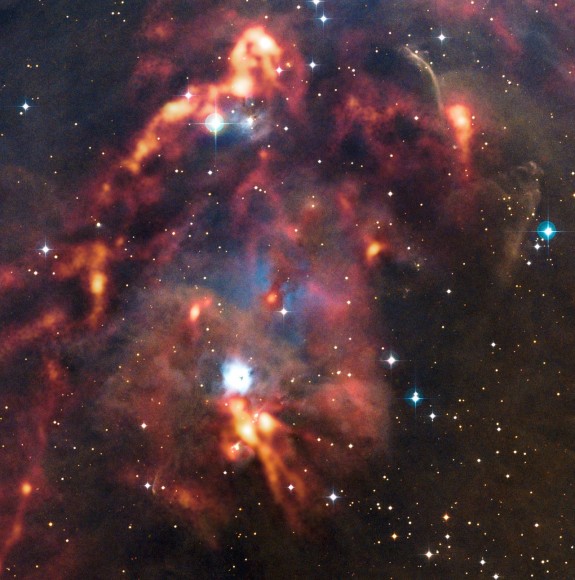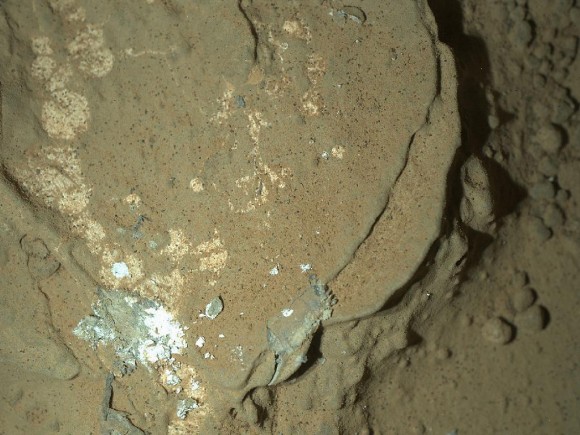Welcome to DU!
The truly grassroots left-of-center political community where regular people, not algorithms, drive the discussions and set the standards.
Join the community:
Create a free account
Support DU (and get rid of ads!):
Become a Star Member
Latest Breaking News
General Discussion
The DU Lounge
All Forums
Issue Forums
Culture Forums
Alliance Forums
Region Forums
Support Forums
Help & Search
n2doc
n2doc's Journal
n2doc's Journal
January 26, 2013

A new image from ESO’s APEX instrument shows a cloud of gas and dust in the Orion region. Image credit: ESO
When astronomers see dark regions in nebula in visible light, they know there’s something going on. There’s got to be some kind of star forming activity pumping out material that obscures the view to the newly forming starts. Switch to infrared and you can peer through that intervening dust to see the young stars at work.
Astronomers using the European Southern Observatory’s Atacama Pathfinder Experiment (APEX) telescope in Chile were surprised to see a dark region in the nebula NGC 1999, even in infrared, when the cause of the dark region should have been apparent.
Ooo, mystery.
Read more: http://www.universetoday.com/99596/in-orion-there-really-is-a-hole-in-the-sky/
In Orion, There Really is a Hole in the Sky

A new image from ESO’s APEX instrument shows a cloud of gas and dust in the Orion region. Image credit: ESO
When astronomers see dark regions in nebula in visible light, they know there’s something going on. There’s got to be some kind of star forming activity pumping out material that obscures the view to the newly forming starts. Switch to infrared and you can peer through that intervening dust to see the young stars at work.
Astronomers using the European Southern Observatory’s Atacama Pathfinder Experiment (APEX) telescope in Chile were surprised to see a dark region in the nebula NGC 1999, even in infrared, when the cause of the dark region should have been apparent.
Ooo, mystery.
Read more: http://www.universetoday.com/99596/in-orion-there-really-is-a-hole-in-the-sky/
January 26, 2013

Image caption: This image of a Martian rock illuminated by white-light LEDs (light emitting diodes) is part of the first set of nighttime images taken by the Mars Hand Lens Imager (MAHLI) camera at the end of the robotic arm of NASA’s Mars rover Curiosity. The image was taken on Jan. 22, 2013, after dark on Sol 165. It covers an area about 1.3 inches by 1 inch (3.4 by 2.5 centimeters). Credit: NASA/JPL-Caltech/MSSS
Curiosity’s high resolution robotic arm camera has just snapped the 1st set of night time images of a Martian rock of the now 5 1/2 month long mission – using illumination from ultraviolet and white light emitting LED’s. See the images above and below.
The Mars Hand Lens Imager (MAHLI) camera is located on the tool turret at the end of Curiosity’s 7 foot (2.1 m) long robotic arm.
MAHLI took the close-up images of a rock target named “Sayunei” on Jan. 22 (Sol 165), located near the front-left wheel after the rover had driven over and scuffed the area to break up rocks in an effort to try and expose fresh material, free of obscuring dust.
Read more: http://www.universetoday.com/99622/curiositys-robotic-arm-camera-snaps-1st-night-images/#ixzz2J2YBZIEW
Curiosity’s Robotic Arm Camera Snaps 1st Night Images

Image caption: This image of a Martian rock illuminated by white-light LEDs (light emitting diodes) is part of the first set of nighttime images taken by the Mars Hand Lens Imager (MAHLI) camera at the end of the robotic arm of NASA’s Mars rover Curiosity. The image was taken on Jan. 22, 2013, after dark on Sol 165. It covers an area about 1.3 inches by 1 inch (3.4 by 2.5 centimeters). Credit: NASA/JPL-Caltech/MSSS
Curiosity’s high resolution robotic arm camera has just snapped the 1st set of night time images of a Martian rock of the now 5 1/2 month long mission – using illumination from ultraviolet and white light emitting LED’s. See the images above and below.
The Mars Hand Lens Imager (MAHLI) camera is located on the tool turret at the end of Curiosity’s 7 foot (2.1 m) long robotic arm.
MAHLI took the close-up images of a rock target named “Sayunei” on Jan. 22 (Sol 165), located near the front-left wheel after the rover had driven over and scuffed the area to break up rocks in an effort to try and expose fresh material, free of obscuring dust.
Read more: http://www.universetoday.com/99622/curiositys-robotic-arm-camera-snaps-1st-night-images/#ixzz2J2YBZIEW
Profile Information
Gender: Do not displayMember since: Tue Feb 10, 2004, 01:08 PM
Number of posts: 47,953

















































